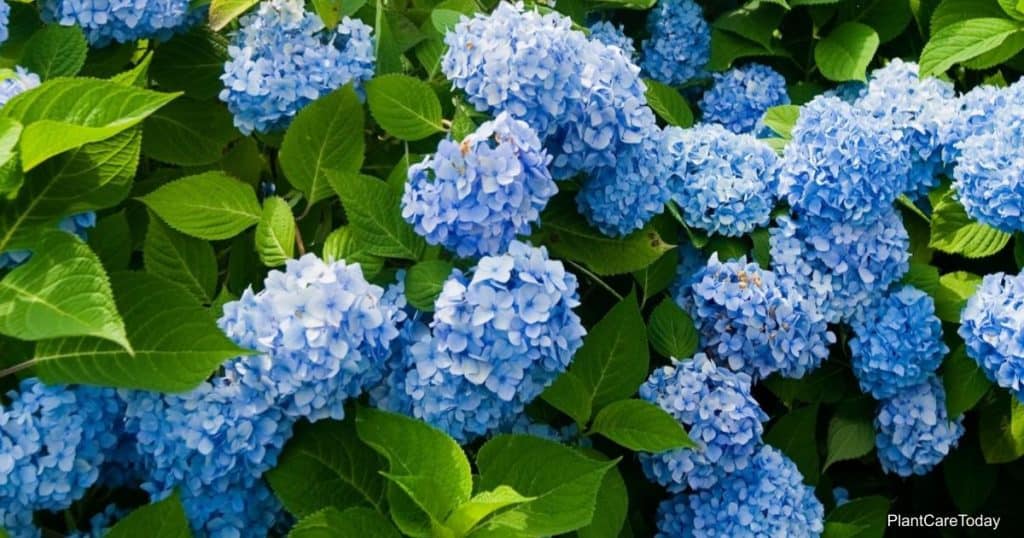Hydrangeas are a popular flowering shrub found throughout North America. Large, green leaves and showy, colorful flowers characterize them.
While the Hydrangea genus contains 23 species, the most common type found throughout North American landscapes is the French Hydrangea – Hydrangea macrophylla.

The Hydrangea plant is easily recognizable with clusters of flowers, which can be white, pink, purple, red, or blue. They’ll grow to several feet in height and width. Easy to prune, they thrive in USDA Hardiness Zone Eight. They require rich soil, full sun, plenty of water, cold protection, and fertilizer.
When To Fertilize Hydrangea?
Fertilize hydrangeas twice a year, once in the early spring (May) and again in the early summer (July). You can use nursery-standard NPK ratio 10-10-10 or 15-30-15 fertilizer for most hydrangeas.
Another popular option is the use of fertilizers with higher levels of phosphorus, often referred to as “bloom Booster fertilizers.” They encourage robust flower growth and are usually applied after the first flowering of the season.
Factors to Consider with Hydrangea Fertilization
Fertilization can help all types of Hydrangea plants thrive, but it’s essential to use the right fertilizer and apply it the right way. Otherwise, you risk damaging or even killing your plants. Here’s a closer look at what works best:
What Is The Best Type of Fertilizer For Hydrangeas?
Hydrangea fertilizer is labeled with three numbers, representing the percentage of nitrogen, phosphorus, and potassium. 10-10-10 fertilizer is considered an all-purpose fertilizer for outdoor vegetation such as turf grass, perennials, and leafy green plants (like hydrangeas).

Nitrogen promotes vegetative growth, such as leaves. A formula with an equal ratio helps the plant produce leaves and edible foliage. Note that 10-10-10 doesn’t just represent the percentage of nutrients; it also indicates a quantity appropriate for the hydrangea’s feeding needs.
You can use fertilizers to help increase the number of flower buds. Often called “bloom boosters,” they have a high phosphorus content (the middle number), which increases the size and number of flowers. 15-30-15 is another popular option. A bloom booster is usually most effective after the season’s first flowering flush.
When to Apply Fertilizer
Fertilize hydrangeas twice a year, once in the early spring and again in the early summer.
Most people apply fertilizer in May when the plants start leafing out. Then, feed them again during the growing season, which is around July. A second feeding is especially crucial in warmer climates.
It’s essential to understand when to stop fertilization. Never add fertilizer after August. The resulting lush, tender growth that occurs interferes with the plant’s ability to protect itself during winter adequately and can result in severe and long-term damage.
Related: Hydrangea Leaves Turning Yellow – Why?
How to Apply Hydrangea Fertilizer
Apply a light fertilizer coating around the branches’ drip line to the base. The drip line is about two feet beyond where water drips off the ends of the plant. If using a slow-release fertilizer, cover it with a light coat of soil or compost.
NOTE: Do not apply fertilizers next to the stems or trunk of your Hydrangea.
Next, water the area thoroughly. Watering helps fertilizer soak into the soil and connect with the Hydrangeas root system, which is about 10’ feet underground. If you don’t want to water manually, try to apply the fertilizer before a light to a moderate rainstorm.

How Much Fertilizer to Apply
Annually, shrubs and bushes can receive up to four pounds of nitrogen per 1,000 square feet of root spread. Generally, lean more towards about two pounds per year for a Hydrangea. Too much fertilizer can weaken the plant’s structure and defense ability.
Two signs of overfertilization are leaves with burned edges and a salty crust on the soil. At the first sign of a problem, you want to flood your garden with water equivalent to the fertilized space’s cubic area. While overfertilization damage can’t always be prevented, quick and extensive water can help mitigate the damage.
Related: Should You Deadhead Hydrangeas?
Fertilizer and Color Changes
You can fertilize hydrangeas in ways that affect their color:
- Sulfur turns the flowers blue and purple.
- Lime turns the flowers pink.
Note: White hydrangeas can’t change color.
The chemical composition of the Hydrangea soil determines the color of the flower. Blue flowers will grow if the soil has a low pH level and a high aluminum level. However, if the soil has a high pH level and a low aluminum level, pink flowers will bloom.
More on: How To Make Hydrangeas Blue
Using soil amendments, you can raise or lower the soil’s pH level as needed. A soil test can tell you the current pH level of your soil, which can help you estimate how long a color shift will take.